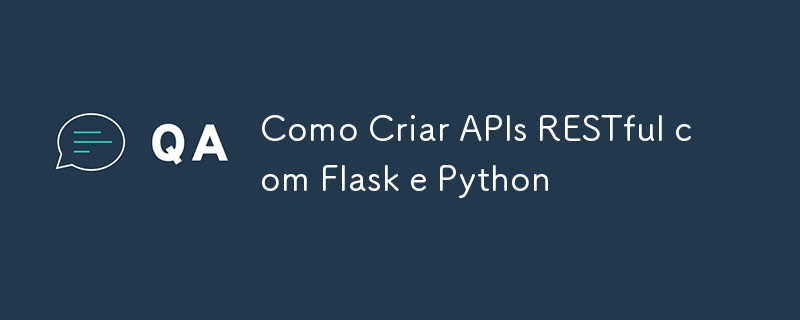

RESTful APIs are essential in modern development, allowing different systems to communicate in an efficient and scalable way. Python, with its Flask framework, offers a simple and powerful approach to creating APIs. In this guide, we'll explore how to create a RESTful API using Flask, covering everything from the basics to authentication and consumption with HTTP clients.
Before we start with the code, it is important to understand what a RESTful API is. API (Application Programming Interface) is a set of rules that allow one software to communicate with another. The REST (Representational State Transfer) style defines a set of principles that the API must follow:
Now we will create a simple API that manages a list of users. The API will allow you to add, edit, view and delete users.
First, make sure you have Flask installed. If not, you can install it using pip:
pip install Flask
Our project will have the following structure:
/api_flask │ ├── app.py └── requirements.txt
In the app.py file, we start by importing the necessary libraries and configuring our Flask application:
from flask import Flask, jsonify, request
app = Flask(__name__)
# Dados simulados
users = [
{'id': 1, 'name': 'Alice', 'email': 'alice@example.com'},
{'id': 2, 'name': 'Bob', 'email': 'bob@example.com'}
]
Now, let's create our endpoints for view, add, update and delete users.
We will use the GET method to list all users:
@app.route('/users', methods=['GET'])
def get_users():
return jsonify(users), 200
We will use the GET method with the user ID to get details of a specific user:
@app.route('/users/<int:user_id>', methods=['GET'])
def get_user(user_id):
user = next((user for user in users if user['id'] == user_id), None)
if user:
return jsonify(user), 200
else:
return jsonify({'message': 'User not found'}), 404
The POST method will be used to add a new user. The client will send the data in JSON format.
@app.route('/users', methods=['POST'])
def create_user():
data = request.get_json()
new_user = {
'id': len(users) + 1,
'name': data['name'],
'email': data['email']
}
users.append(new_user)
return jsonify(new_user), 201
Here we use the PUT method to update the data of an existing user:
@app.route('/users/<int:user_id>', methods=['PUT'])
def update_user(user_id):
data = request.get_json()
user = next((user for user in users if user['id'] == user_id), None)
if user:
user['name'] = data['name']
user['email'] = data['email']
return jsonify(user), 200
else:
return jsonify({'message': 'User not found'}), 404
We use the DELETE method to remove a user:
@app.route('/users/<int:user_id>', methods=['DELETE'])
def delete_user(user_id):
global users
users = [user for user in users if user['id'] != user_id]
return jsonify({'message': 'User deleted'}), 200
Now, just run our application:
if __name__ == '__main__':
app.run(debug=True)
Running the app.py file, our API will be available at http://127.0.0.1:5000/users.
To add a layer of security to our API, we can use JWT (JSON Web Token). With JWT, we can ensure that only authenticated users can access certain endpoints.
Install the required extension:
pip install Flask-JWT-Extended
Update your app.py file to include JWT authentication:
from flask_jwt_extended import JWTManager, create_access_token, jwt_required
app.config['JWT_SECRET_KEY'] = 'your-secret-key' # Troque pela sua chave secreta
jwt = JWTManager(app)
# Login para obter o token
@app.route('/login', methods=['POST'])
def login():
data = request.get_json()
if data['username'] == 'admin' and data['password'] == 'admin':
access_token = create_access_token(identity={'username': 'admin'})
return jsonify(access_token=access_token), 200
else:
return jsonify({'message': 'Invalid credentials'}), 401
# Exemplo de endpoint protegido
@app.route('/protected', methods=['GET'])
@jwt_required()
def protected():
return jsonify({'message': 'Access granted to protected endpoint'}), 200
Now, when accessing the /protected endpoint, it will be necessary to send the JWT token in the request header to authenticate the user.
To consume the API, we can use tools like Postman or libraries like requests in Python.
Example of how to consume the API using requests:
import requests
# Consumindo o endpoint de listagem de usuários
response = requests.get('http://127.0.0.1:5000/users')
print(response.json())
Creating a RESTful API with Flask is straightforward and flexible. Flask offers a minimalist framework that can be expanded to include features such as authentication, error handling, and other layers of security. By following REST principles and good development practices, it is possible to build efficient and scalable APIs with Python.
Now you can build your own RESTful API with Flask, customizing as per your needs and requirements.
The above is the detailed content of How to Create RESTful APIs with Flask and Python. For more information, please follow other related articles on the PHP Chinese website!
 The difference between gateway and router
The difference between gateway and router
 How to recover files emptied from Recycle Bin
How to recover files emptied from Recycle Bin
 How to fix libcurl.dll missing from your computer
How to fix libcurl.dll missing from your computer
 Delete exif information
Delete exif information
 WiFi shows no access to the Internet
WiFi shows no access to the Internet
 My computer can't open it by double-clicking it.
My computer can't open it by double-clicking it.
 How to restore friends after being blocked on TikTok
How to restore friends after being blocked on TikTok
 Introduction to javascript special effects code
Introduction to javascript special effects code




